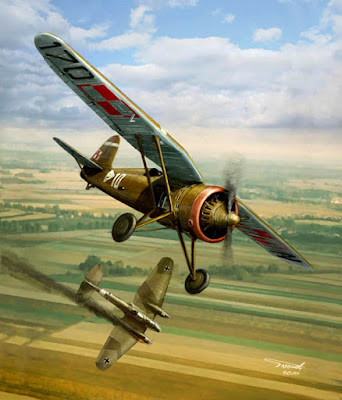The backbone of the Polish fighter force were the PZL P7a and its later development, the PZL P11c, identifiable by its monoplane gull wings and fixed undercarriage.
The mainstay of the Polish bomber and reconnaissance force was the light bomber PZL P23 'karas'.
There were plenty of other aircraft but in much smaller numbers. Some of these aircraft such as the PZL P37 'los' medium bomber and PZL P50 'jastrzab' fighter were much more advanced contemporary designs but were in such small numbers they were incapable of having a quantifiable impact on the war.
 |
| A PZL P11c shooting down a German Heinkel He111 |
The PZL. P11c was designed in the early 1930's by PZL in Warsaw. For a very brief period this was the most advanced fighter design in the world being an all metal monoplane fighter at a time when even the Royal Air Force was still using the Hawker Fury biplane as its mainstay of the fighter force.
 |
| PZL P11c on a extendable flying base |
The design attracted a lot of attraction world wide and was produced in numerous variants. The final variant was the P11c which had a refined fuselage, a lowered engine in the nose improving the pilots view with the central part of the gull wing (internationally known as a Pulawski wing, after its developer Zygmunt Pulawski) modified for strength and visibility as well.
 |
| PZL P11c squadron lined up ready for action |
At the outbreak of the war the Poles had only 150 or so operational fighter planes in 10 escadrilles (squadrons). Two squadrons constituted a group and two groups (four squadrons) were collected together into an organisation called the Pursuit Brigade which was tasked with defending Warsaw against German bomber formations that were expected. The rest were distributed between the various army groups that Poland had in the field.
Contrary to the propaganda which stated that the Polish airforce had been destroyed on the ground, these squadrons had been distributed to wartime improvised airstrips and prepared for action.
The P11c would be up against the German bombers which flew faster than they did as well as the German fighter screens of the Messerschmitt BF109 and Me110 both of which were faster and better armed than the Polish planes. On top of all of this the Polish planes has seen considerable intensive use before the war and so were actually slower than their stated speeds.
However the Polish P11c was tough and durable, had better manoeuvrability profiles than their opponents, had a good rate of climb and could take off from very short airstrips and could dive so fast that pilots would be in danger of passing out from G forces long before the risk of wing structure collapse became an issue. Despite total supposed German superiority the Polish fighter planes managed to shoot down at least 110 confirmed air victories although suffering heavily in the process losing 100 of their own machines. This number of 110 comes from German war records and as some of the downed aircraft were recovered and put back into immediate service may have been noticeably higher in fact.
 |
| A look at the details on the PZL P11c |
The model that I finally managed to find after a VERY long time looking is a 1/100 PZL P11c from Lil' Flyin' Fokkers which can be found from Old Glory Miniatures UK, and it represents one of the P11c's that had four machine guns. I went through a variety of colour schemes but ended up with a Khaki Drab base colour with Chocolate Brown panel lines finally airbrushed lightly over the top with Vallejo Air Tank Green, which I feel has given me a colour which would accurately represent the colours of the Polish fighter force of the day.
So... this should keep those pesky Stukas at bay!


Thanks Phil, you're too kind! :D
ReplyDelete